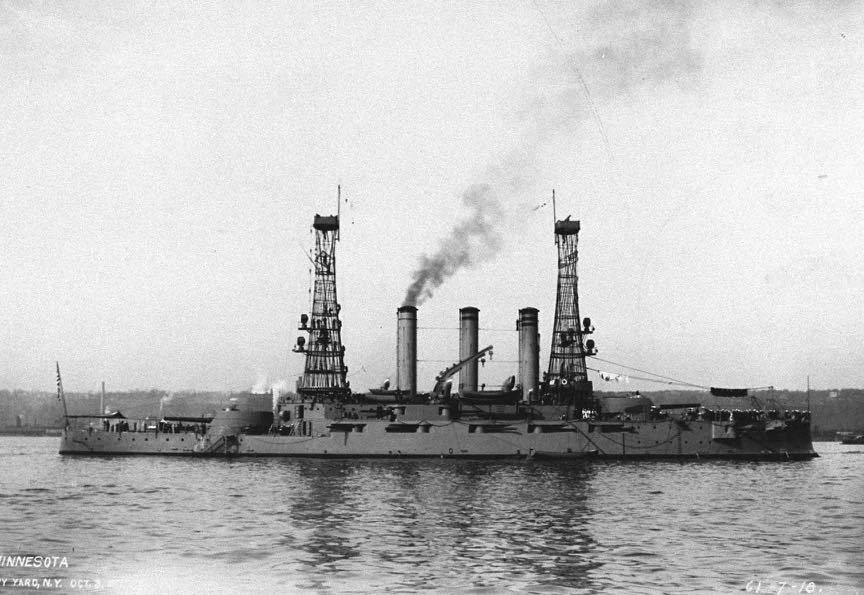USS Minnesota BB-22

Minnesota II
(BB-22: displacement 10,000; length 456'4"; beam 76'10"; draft 24'6" (mean); speed 18 knots; complement 880; armament 4 12-inch guns, 8 8-inch guns, 12 7-inch guns, 20 3-inch guns, 12 3-pounders, 4 21-inch torpedo tubes; class Connecticut)
The second USS Minnesota (BB-22) was laid down by the Newport News Shipbuilding Co., Newport News, Virginia, on October 27, 1903; launched on April 8, 1905, sponsored by Miss Rose Marie Schaller; and commissioned on March 9, 1907, with Captain J. Hubbard in command.
Following her shakedown off the New England coast, Minnesota was assigned to duty in connection with the Jamestown Exposition in Jamestown, Virginia, from April 22 to September 3, 1907. On December 16, she departed Hampton Roads as one of the 16 battleships sent by President Theodore Roosevelt on a voyage around the world. The cruise of the 'Great White Fleet,' lasting until February 22, 1909, served as a deterrent to possible hostilities in the Pacific, raised American prestige as a global naval power, and, most importantly, impressed upon Congress the need for a strong navy and a thriving merchant fleet to keep pace with the United States' expanding international interests and far-flung possessions.
Returning from her world cruise, Minnesota resumed operations with the Atlantic Fleet. Over the next three years, she primarily operated along the East Coast, with one brief deployment to the English Channel. In 1912, her schedule began to involve her more in inter-American affairs. During the first half of that year, she cruised in Cuban waters and was stationed at Guantanamo Bay from June 7 to 22, supporting actions aimed at establishing order during the Cuban insurrection. The following spring and summer, she cruised in Mexican waters. In 1914, she twice returned to Mexican waters (January 26 to August 7 and October 11 to December 19) as the country continued in political turmoil. In 1915, she resumed East Coast operations, with occasional cruises to the Caribbean area, which she continued until November 1916 when she became the flagship of the Reserve Force, Atlantic Fleet.
On April 6, 1917, as the United States entered World War I, Minnesota rejoined the active fleet at Tangier Sound, Chesapeake Bay, and was assigned to Division 4, Battleship Force. During World War I, she served as a gunnery and engineering training ship, cruising off the middle Atlantic seaboard until September 27, 1918. On that date, 20 miles from Fenwick Island Shoal Lightship (38°11' N.; 74°41' W.), she struck a mine, apparently laid by the German submarine U-117. Suffering serious damage to the starboard side but with no loss of life, she managed to reach Philadelphia, where she underwent five months of repairs. On March 11, 1919, she returned to sea as a unit of the Cruiser and Transport Force. Assigned to that force until July 23, she completed three round trips to Brest, France, returning over 3,000 veterans to the United States.
Primarily employed thereafter as a training ship, Minnesota took midshipmen on two summer cruises (1920 and 1921) before being decommissioned on December 1, 1921. Struck from the Naval Register the same day, she was dismantled at the Philadelphia Navy Yard, and on January 23, 1924, was sold for scrap.
 >
>